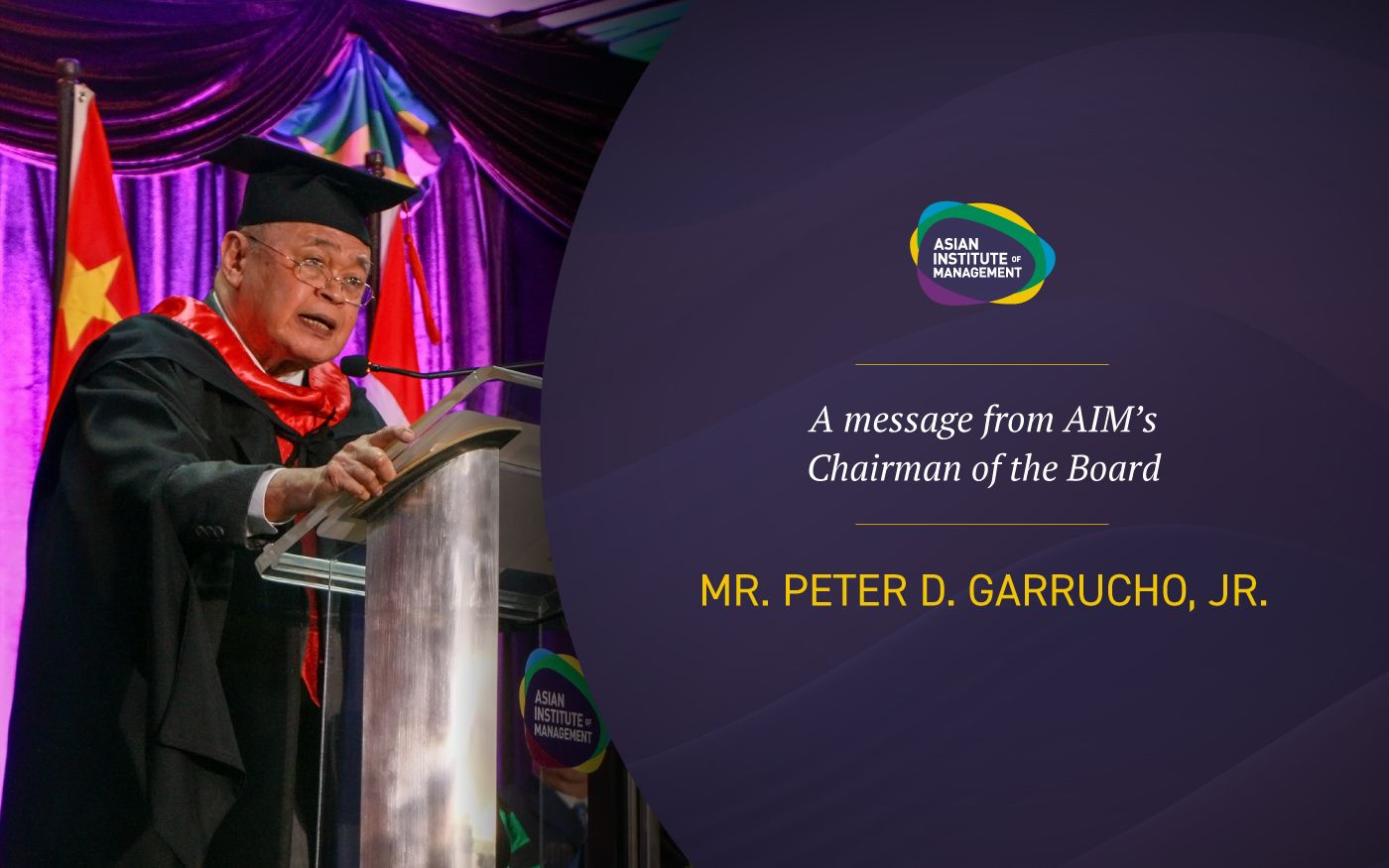Graduates of 2023, Parents, Spouses and Significant others, Professors, Ladies and Gentlemen,
When our President Jikyeong Kang asked me to speak at your Graduation, I attempted to decline arguing that I had already spoken at an AIM Graduation back in 1992 when I had just stepped down as Secretary of the Department of Trade and Industry. President Kang replied that hardly anyone will remember that. True. In fact a number of you graduating today may not have even been born in 1992. So I relented.
At any rate, I tried to recall what I said that afternoon. In addressing the graduates of the Master in Business Management (the MBM which would be renamed the MBA). My main message was to prepare for a much more competitive world as the pace of globalization was accelerating. I had a front row seat of this worldwide development when I served as Secretary of Trade and Industry. When we in the Department would meet with our counterparts in the US, the European Union, or together as Southeast Asian countries in AFTA, the ASEAN Free Trade Area, the persistent theme was to grant market access by lowering tariffs, open up closed industries, remove quotas where they existed, and harmonize rules and regulations toward a global standard. That seemed reasonable enough but as expected, protected industries would raise a collective howl. Corporate leaders would be joined by their labor unions in defiance. Because agriculture was also liberalized, farmers even in developed countries like Japan and South Korea also raised their objections.
Today, Globalization prevails as it has been generally conceded that it has brought much prosperity around the world. Many industries and countries have prospered and more important, the consumer has benefited with much more product choices and lower prices. Some countries have emerged as big winners. China is one such big winner as it became the World’s Manufacturing powerhouse that it still is today. Take the smartphone. Designed in Silicon Valley but manufactured in China. Countries like Korea and now China have followed with their own cellphone versions.
Indeed, Globalization is here, but there’s also some Pushback. Some resistance has arisen because of Supply Chain problems. When container vessels could not unload their cargoes in major shipping ports like Los Angeles, New York, Savannah, and other major US ports, over several weeks, there was chaos. And when a super tanker ran aground in the Suez Canal, there was panic. This has led countries like the US to Call for Self Sufficiency especially for their industries such as communications that have sensitive national security concerns.
There was another major economic program for which I later also had a front row seat. This was the Privatization of Government Economic Activity. When I was offered the position of Managing Director for Energy by First Philippine Holdings, government had just started to encourage the private sector to invest in what had been a traditionally exclusive public sector activity–power generation. They started the Build Operate and Transfer Program or the BOT. A private company would build a power plant, obtain financing, operate it, sell the power back to government following an agreed formula, and at the end of the contract, say 15 years, transfer the whole facility back to government. Investors loved these businesses because the economics were generous. Banks and other lenders were enthusiastic because the contracts had government guarantees. Power equipment manufacturers were keen to get more business from a competent and disciplined operator with solid finances. It was almost a license to print money. Under such a policy environment, we built our Bauang Diesel Plant of 220 megawatts with a Capex of roughly $200 million. And so did some electricity companies from the US and Korea.
Government was happy with the BOT as the additional capacity didn’t have to burden the national budget. Yet, consumers would slowly but surely stop grumbling about brownouts. And overall, economic activity grew because power supplies were sufficient. Following that policy change, government decided to go one step further. They would privatize their existing plants through competitive bidding. Thus money, large sums of it, would flow to the Treasury. With that policy shift, our Energy group bidded and won the Casecnan Masiway hydroelectric power plants in Nueva Ecija with roughly 165 megawatts. But there would be a much bigger enterprise in the horizon. The PNOC Energy Development Corporation. A multi plant complex, mostly in geothermal, a renewable source of energy. The privatization of government enterprises is not just a Philippine phenomenon. It’s world wide. I think its most scandalous version was in Russia where oil and gas companies, banks, manufacturing firms were transferred for modest sums to friends of the Kremlin, later called by the international media as the Oligarchs, new billionaires who would later buy mansions in London, oversized yachts, and even football clubs in the Premier League.
Yet despite such developments, it cannot be denied that properly executed this wave of Privatization vastly improved consumer welfare and led to fresh investments in other sectors. Water distribution was later privatized. So was the LRT and MRT. And the Cebu Airport. In power generation, suppliers would share stories of how in the past, the equipment they sold to government had been poorly maintained and budgets for spare parts would balloon. Some government officials had limited incentive to be efficient as the excessive costs would be covered by the national budget anyway. With privatization and the later creation of an Electricity Spot Market, the spirit of competition was introduced in power generation. Someday, some scholar should summarize the total value of this transfer of economic activity from the government to the private sector.
So many high quality decisions had to be made, so we at First Holdings went on a recruitment and hiring of AIM MBAS who became our workhorses and they contributed significantly to our early success. Later, various companies in our group would send our mid level managers to the EMBA. Many other business groups plunged into these privatized government enterprises and recruited young men and women who might not have otherwise joined government to fortify their expanding businesses. The Aboitizes come to mind in power, the Ayalas in water, and the Pangilinan group in rail transport.
These large projects had long operating lives, required large sums in equity and debt, demanded many government approvals, and were heavily regulated. Thus, many management disciplines had to be in place. We had to decide on which equipment, Siemens, GE, or ABB to purchase, which control systems to assist daily plant operations. We had to recruit and hire engineers, accountants, lawyers, and other professionals. We had to obtain approvals from national and local governments and purchase property from landowners. We had to borrow from international and local banks and deal with export development agencies. Getting the approval of a KFW of Germany or a US EXIM was a badge of honor. We had to generate regular financial statements especially when we got listed in the stock exchange. And inevitably, we had to engage consultants, technical and financial advisers, and lawyers to guide us. These assorted advisers had to be carefully chosen and engaged. Because they did not come cheap, they considered themselves part of The Food Chain for major Infrastructure enterprises. There is a growing need for power, preferably Clean Power, so these enterprises will grow.
Moreover, there are new technologies that would have to be studied and decided on in order to meet Climate Change targets. Natural gas is a transition fuel away from fossil fuels like oil and coal. There is a probable shift to hydrogen first in ocean transport then in power generation, some lithium battery storage, or maybe even a long shot for now, nuclear. There’s a race to adopt the best technology and there’s big money funding such developments. For instance, in the Arabian desert, there’s a mammoth project to develop hydrogen using solar power.
My description of developments with the BOT and the privatization of government enterprises constitute the pattern of less government; and more private sector involvement. The globalization movement also leads to more competition where the firms that prosper are those that are cost efficient, financially healthy, innovative with their products, and organizationally lean and mean. These demands play to the strengths of our MBA Program. And the results affirm this statement. Take our 50th Anniversary Class, MBM ‘73. One member, Polly Nazareno became President of PLDT. And I know that in EDC, a graduate of UP Engineering and of our EMBA Program has recently stepped in as the COO. To my mind, these contribute to the affirmation that AIM has satisfied its mandate of preparing the leaders of our major corporations.
Entrepreneurs
The country’s growth however should not depend only on the mid sized and large corporations. We should have a cadre of many entrepreneurs who will establish new businesses that would accelerate development especially in the high growth sectors that are emerging worldwide.
Stanford University where I was fortunate to have studied is located in Silicon Valley and has recognized strengths in Engineering, the Sciences, Medicine, and Business. It is thus no surprise that with this intellectual capital nearby, there is an overflow of opportunity in communications, electronics, and biotechnology, among other sectors. And there are many angel investors who operate in the area.
I am glad that Program is now part of the Aboitiz School where our Data Science and our Innovation programs are lodged. Moreover, I am glad that Course focuses on the How To of Starting a Business. For starters, Entrepreneurs are the students. The course helps them to navigate the key decision challenges. From identifying opportunities, determining their feasibility, obtaining regulatory approvals, securing financing with debt and equity, setting shareholder agreements, and launching and growing the enterprise. There is some coaching and some sharing among the students that should lead to a more successful startup.
Our principal professors in the Aboitiz School are the country’s stalwarts in Artificial Intelligence. Just this week, I read in the Financial Times that a drug discovered and designed by artificial intelligence has shown much promise. While we have no aspirations of that kind of breakthrough, my hope is that our students benefit from the intellectual ferment and are instilled with the will and fortitude to start an enterprise.
And for inspiration, let me go back again to the Class of 73. A Distinction Graduate of that class, Ashok Soota was such a successful entrepreneur in Bangalore India that he has committed to contribute $2 million to AIM.
Development Managers
Back to 1992, we had just had our first graduating Classes for the Master in Development Program, the MDM. This program emerged because there was a worldwide resistance to what was described as Trickle Down Economics. That approach argued that Simply Support your high growth industries and its benefits will trickle down to the poor and underprivileged. Instead of this Top Down approach to Development, there was a movement especially in the developing countries to start at the Bottom of a Society, organize and fortify the structures and institutions, engage the community in planning and executing their programs, provide development assistance, and economic growth would follow.
But our focus today is on to Disaster and Risk Management. Now also lodged in the Zuellig School. I know a little bit about the subject because Risk Management Committees are now de rigguer in listed companies and I was even made Chairman in Fgen’s. There’s an intellectual rigor to this exercise. The Committee would analyze the Probability of various risk events, high or low, its Impact on Finances, the company’s reputation, and on the Organization. Then we would study how to minimize the risk if it occurred. Basically, How to De Risk. And also what type and level of Insurance to obtain. And failing all that, how to prepare the Organization accordingly.
It’s on that note that I address our EMDRCM Class. We know that the Philippines is located in the Ring of Fire. As I understand it, that stretches from Indonesia to Japan and connects to California and down to Latin America through Peru and Chile. We are vulnerable not just to volcanic eruptions but to earthquakes. There are identified fault lines. A famous one, the Marikina Fault in fact traverses part of White Plains where I have a residence. Moreover, we are regularly visited by typhoons, called hurricanes in North America. And in 2013, Yolanda struck Leyte, where the largest operation of EDC is located.
The company had to go through the usual Management Cycle when disaster struck. Shock and disbelief as it occurred. Assessment of the damage with the focus on human life and injury. Relief and rehabilitation with the focus first on employees and their families and then the community. Determining the Repair and Rehabilitation of the whole facility. Finding spares available in other geothermal power plants worldwide and rushing their transfer to the Philippines. Then triggering the process for insurance claims. And later in the case of EDC, pursuing a program for Future Proofing their facilities.
Through the media, we are told that scientists predict many more disasters will strike the world. Forest fires in North America. Droughts in California and nearby states. Hurricanes in the Caribbean even up to the New England area. The frequent international conferences affirm the conclusion that things will get much worse before they get better or even just stabilize. And the tried and true solutions of the past are fading away. For instance, I read that the frequency of forest fires have been so high that insurance companies, have made policies so expensive. Worse, some companies in the case of forest fires, even decline providing cover. In fact, in a case series I wrote on EDC, one case revolves on the alternative of self insurance. Disaster Risk is worsening. And the skill sets to deal with the matter has to be regularly revisited and strengthened.
The AIM Management Contribution
You might ask, is there a common thread to these seemingly disparate educational programs. I certainly hope so. In these programs, there are Back to Basics characterics. The AIM graduate is Data Dependent to help his or her analysis, he evaluates the short and long term consequences, with quantitative and qualitative tools, and decides on the best course of action. Then he executes the program and monitors results. Because many other actors will help or weaken analysis and execution, he steps forward and provides the leadership for a successful outcome. The analytical rigor of so many cases and his efforts in persuading his colleagues will make the AIM graduate stand out.
The quality of your decisions has to shine through. But decide you must. If you don’t, the organizational grapevine will buzz that you’re a boss who can’t decide, or if you flip flop often. You’re afflicted by Analysis Paralysis. But what if you make bum decisions. That’s a risk. But let me repeat a line made by a former Chief of the Central Bank when he spoke at the Management Association of the Philippines.
He was praised for the quality of his decisions . And he was asked how did he develop that quality. He replied quickly—Experience! But of course, he was asked? how did he build up that experience? Oh, he said, some really bad decisions. Our wish is that your stay at AIM provided you with the forum such that your observations, your analysis, your decisions have been so challenged by your colleagues and your professors that AIM has made you the Outstanding Manager and Leader that I am confident you have become.
A few final messages. Of course, AIM should have been a major part of your Journey to Management and Leadership. But I also hope that you will also commit to some Lifelong Programs. First is Lifelong Wellness. You’re young men and women now, but the stresses of your personal lives and careers will take their toll on your physical and mental health. Be conscious of that. And get professional advice and help. Also I hope you commit to Lifelong Investing. You will likely generate good cash flows as you progress in your careers and I hope you’ve become financially savvy to cover the needs for your families and let’s not forget, for your retirement. Also, I hope you commit to some Lifelong Learning programs. Not just for your careers, but to celebrate the fullness of an Outstanding Citizen and Asian.
And finally, as this will probably be my last formal speech at AIM, let me thank our President and Dean Jikyeong Kang for her outstanding contributions to the Institute. You have done so much for the School. We are forever in your debt.
Congratulations Graduates of 2023! My best wishes for your many successes!





